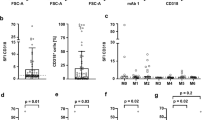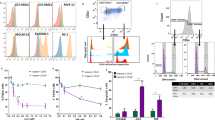Abstract
In view of obscure clinical and biological significance of leukemic cells heterogeneity, we studied the efficacy of apoptosis, proliferation, and expression levels of the Bcl-2, MDR1, LRP, and BCRP genes in sorted CD34+ and CD34− subpopulations of childhood AML leukemic samples. In five out of nine cases, CD34+ cells were less sensitive to spontaneous apoptosis and had from 1.2- to 5.0-fold higher expression levels of Bcl-2 (eight of ten) and from 1.5- to 28.7-fold higher expression levels of MDR1 (eight of ten). The expression levels of the LRP gene were from 1.1- to 1.8-fold higher in CD34+ subpopulations (five of ten cases), and the expression levels of the BCRP gene were from 1.1- to 22.4-fold higher in CD34+ leukemic cells (six of ten). In all M4 cases, the expression levels of LRP were higher in the CD34− subpopulation. Significant differences in the patterns of genes expression between patients do not allow us to conclude that the CD34+ fractions have more resistant phenotype than the CD34− subpopulations. Nevertheless, distinctions between CD34+ and CD34− cells may lead to different chemosensitivities between leukemic subpopulations in vivo and may determine the alteration of the leukemic immunophenotype during treatment and in relapse.




Similar content being viewed by others
References
Ravindranath Y (2003) Recent advances in pediatric lymphoblastic and myeloid leukemia. Curr Opin Oncol 15:23–35
Langebrake C, Brinkmann I, Teigler-Schlegel A, Creutzig U, Griesinger F, Puhlmann U, Reinhardt D (2005) Immunophenotypic differences between diagnosis and relapse in childhood AML: implications for MRD monitoring. Cytometry B Clin Cytom 63:1–9
Zeleznikova T, Babusikova O (2006) The impact of cell heterogeneity and immunophenotypic changes on monitoring minimal residual disease in acute myeloid leukemia. Neoplasma 53:500–506
Baer MR, Stewart CC, Dodge RK, Leget G, Sule N, Mrozek K, Schiffer CA, Powell BL, Kolitz JE, Moore JO, Stone RM, Davey FR, Carroll AJ, Larson RA, Bloomfield CD (2001) High frequency of immunophenotype changes in acute myeloid leukemia at relapse: implications for residual disease detection (Cancer and Leukemia Group B Study 8361). Blood 97:3574–3580
Eisele L, Klein-Hitpass L, Chatzimanolis N, Opalka B, Boes T, Seeber S, Moritz T, Flasshove M (2007) Differential expression of drug resistance-related genes between sensitive and resistant blasts in acute myeloid leukemia. Acta Haematol 117:8–15
Heuser M, Wingen LU, Steinemann D, Cario G, von Neuhoff N, Tauscher M, Bullinger L, Krauter J, Heil G, Döhner H, Schlegelberger B, Ganser A (2005) Gene-expression profiles and their association with drug resistance in adult acute myeloid leukemia. Haematologica 90:1484–1492
Poot M, Gibson LL, Singer L (1997) Detection of apoptosis in live cells by MitoTracker Red CMXRos and SYTO Dye Flow Cytometry. Cytometry 27:358–364
Ormerod MG (1994) Analysis of DNA—general methods. In: Ormerod MG (ed) Flow cytometry. A practical approach. New York, Oxford University Press, pp 119–135
Gabert J, Beillard E, van der Velden VH, Bi W et al (2003) Standardization and quality control studies of ‘real-time’ quantitative reverse transcriptase polymerase chain reaction of fusion gene transcripts for residual disease detection in leukemia—a Europe Against Cancer program. Leukemia 17:2318–2357
Dworzak MN, Froschl G, Printz D, Mann G, Potschger U, Muhlegger N, Fritsch G, Gadner H (2002) Prognostic significance and modalities of flow cytometric minimal residual disease detection in childhood acute lymphoblastic leukemia. Blood 99:1952–1958
Sievers EL, Lange BJ, Alonzo TA, Gerbing RB, Bernstein ID, Smith FO, Arceci RJ, Woods WG, Loken MR (2003) Immunophenotypic evidence of leukemia after induction therapy predicts relapse: results from a prospective Children's Cancer Group study of 252 patients with acute myeloid leukemia. Blood 101:3398–3406
Langebrake C, Creutzig U, Dworzak M, Hrusak O, Mejstrikova E, Griesinger F, Zimmermann M, Reinhardt D (2006) Residual disease monitoring in childhood acute myeloid leukemia by multiparameter flow cytometry: the MRD-AML-BFM Study Group. Clin Oncol 24:3686–3692
Smith BD, Bambach BJ, Vala MS, Barber JP, Enger C, Brodsky RA, Burke PJ, Gore SD, Jones RJ (1998) Inhibited apoptosis and drug resistance in acute myeloid leukaemia. Br J Haematol 102:1042–1049
van Stijn A, van der Pol MA, Kok A, Bontje PM, Roemen GMJM, Beelen RHJ, Ossenkoppele GJ, Schuurhuis GJ (2004) Differences between the CD34+ and CD34− blast compartment in apoptosis resistance in acute myeloid leukemia. Haematologica 88:497–508
Kornblau SM, Qiu YH, Bekele BN, Cade JS, Zhou X, Harris D, Jackson CE, Estrov Z, Andreeff M (2006) Studying the right cell in acute myelogenous leukemia: dynamic changes of apoptosis and signal transduction pathway protein expression in chemotherapy resistant ex-vivo selected “survivor cells”. Cell Cycle 5:2769–2777
Stanke K, Eckhoff S, Mohr A, Meyer LH, Debatin K-M (2003) Apoptosis induction in peripheral leukemia cells by remission induction treatment in vivo: selective depletion and apoptosis in a CD34+ subpopulation of leukemia cells. Leukemia 17:2130–2139
Banker DE, Groudine M, Norwood T, Appelbaum FR (1997) Measurement of spontaneous and therapeutic agent-induced apoptosis with BCL-2 protein expression in acute myeloid leukemia. Blood 89:243–255
Karakas T, Maurer U, Weidmann E, Miething CC, Hoelzer D, Bergmann L (1998) High expression of bcl-2 mRNA as a determinant of poor prognosis in acute myeloid leukemia. Ann Oncol 9:159–165
Del Poeta G, Venditti A, Del Principe MI, Maurillo L, Buccisano F, Tamburini A, Cox MC, Franchi A, Bruno A, Mazzone C, Panetta P, Suppo G, Masi M, Amadori S (2003) Amount of spontaneous apoptosis detected by Bax/Bcl-2 ratio predicts outcome in acute myeloid leukemia (AML) . Blood 101:2125–2131
Lauria F, Raspadori D, Rondelli D, Ventura MA, Fiacchini M, Visani G, Forconi F, Tura S (1997) High bcl-2 expression in acute myeloid leukemia cells correlates with CD34 positivity and complete remission rate. Leukemia 11:2075–2078
van Stijn A, Feller N, Kok A, van der Pol MA, Ossenkoppele GJ, Schuurhuis GJ (2005) Minimal residual disease in acute myeloid leukemia is predicted by an apoptosis-resistant protein profile at diagnosis. Clin Cancer Res 11:2540–2546
Schaich M, Soucek S, Thiede C, Ehninger G, Illmer T, SHG AML96 Study Group (2005) MDR1 and MRP1 gene expression are independent predictors for treatment outcome in adult acute myeloid leukaemia. Br J Haematol 128:324–332
Benderra Z, Faussat AM, Sayada L, Perrot JY, Tang R, Chaoui D, Morjani H, Marzac C, Marie JP, Legrand O (2005) MRP3, BCRP, and P-glycoprotein activities are prognostic factors in adult acute myeloid leukemia. Clin Cancer Res 11:7764–7772
Filipits M, Pohl G, Stranzl T, Suchomel RW, Scheper RJ, Jager U, Geissler K, Lechner K, Pirker R (1998) Expression of the lung resistance protein predicts poor outcome in de novo acute myeloid leukemia. Blood 91:1508–1513
te Boekhorst PA, de Leeuw K, Schoester M, Wittebol S, Nooter K, Hagemeijer A, Lowenberg B, Sonneveld P (1993) Predominance of functional multidrug resistance (MDR-1) phenotype in CD34+ acute myeloid leukemia cells. Blood 82:3157–3162
Suarez L, Vidriales B, Garcia-Larana J, Lopez A, Martinez R, Martin-Reina V, Tormo M, Gonzalez-San Miguel JD, Lavilla E, Garcia-Boyero R, Orfao A, San Miguel JF, PETHEMA Cooperative Group (2001) Multiparametric analysis of apoptotic and multi-drug resistance phenotypes according to the blast cell maturation stage in elderly patients with acute myeloid leukemia. Haematologica 86:1287–1295
van den Heuvel-Eibrink MM, van der Holt B, Burnett AK, Knauf WU, Fey MF, Verhoef GE, Vellenga E, Ossenkoppele GJ, Lowenberg B, Sonneveld P (2007) CD34-related coexpression of MDR1 and BCRP indicates a clinically resistant phenotype in patients with acute myeloid leukemia (AML) of older age. Ann Hematol 86:329–337
Suvannasankha A, Minderman H, O, ' KL, Nakanishi T, Greco WR, Ross DD, Baer MR (2004) Breast cancer resistance protein (BCRP/MXR/ABCG2) in acute myeloid leukemia: discordance between expression and function. Leukemia 18:1252–1257
Venditti A, Del Poeta G, Maurillo L, Buccisano F, Del Principe MI, Mazzone C, Tamburini A, Cox C, Panetta P, Neri B, Ottaviani L, Amadori S (2004) Combined analysis of bcl-2 and MDR1 proteins in 256 cases of acute myeloid leukemia. Haematologica 89:934–939
Leith CP, Kopecky KJ, Chen I-M, Eijdems L, Slovak ML, McConnell TS, Head DR, Weick J, Grever MR, Appelbaum FR, Willman CL (1999) Frequency and clinical significance of the expression of the multidrug resistance proteins MDR1/P-Glycoprotein, MRP1, and LRP in acute myeloid leukemia. A Southwest Oncology Group Study. Blood 94:1086–1099
Sunnaram BL, Gandemer V, Sebillot M, Grandgirard N, Amiot L, Leray E, Goasguen JE (2003) LRP overexpression in monocytic lineage. Leuk Res 27:755–759
Scharenberg CW, Harkey MA, Torok-Storb B (2002) The ABCG2 transporters is an efficient Hoechst 33342 efflux pump and is preferentially expressed by immature human hematopoietic progenitors. Blood 99:507–512
Bunting KD (2002) ABC transporters as phenotypic markers and functional regulators of stem cells. Stem Cells 20:11–20
Peeters SD, van der Kolk DM, de Haan G, Bystrykh L, Kuipers F, de Vries EG, Vellenga E (2006) Selective expression of cholesterol metabolism genes in normal CD34+CD38− cells with a heterogeneous expression pattern in AML cells. Exp Hematol 34:622–630
Acknowledgements
We would like to thank Utskevich R, Stasevich I, Valochnik A, Savitskaya T, and Krivko M for the data on cytogenetics and FLT3 mutation. This study has been partially supported by a grant (B06-197) from the Belarusian Foundation for Fundamental Research.
Author information
Authors and Affiliations
Corresponding author
Rights and permissions
About this article
Cite this article
Shman, T.V., Fedasenka, U.U., Savitski, V.P. et al. CD34+ leukemic subpopulation predominantly displays lower spontaneous apoptosis and has higher expression levels of Bcl-2 and MDR1 genes than CD34− cells in childhood AML. Ann Hematol 87, 353–360 (2008). https://doi.org/10.1007/s00277-008-0439-2
Received:
Accepted:
Published:
Issue Date:
DOI: https://doi.org/10.1007/s00277-008-0439-2




